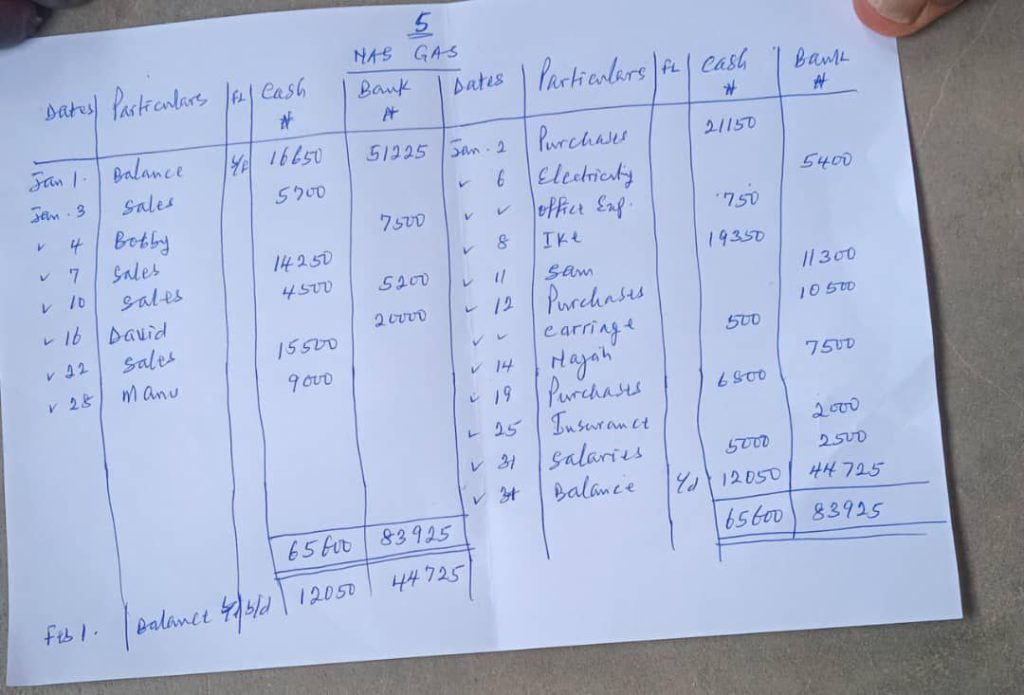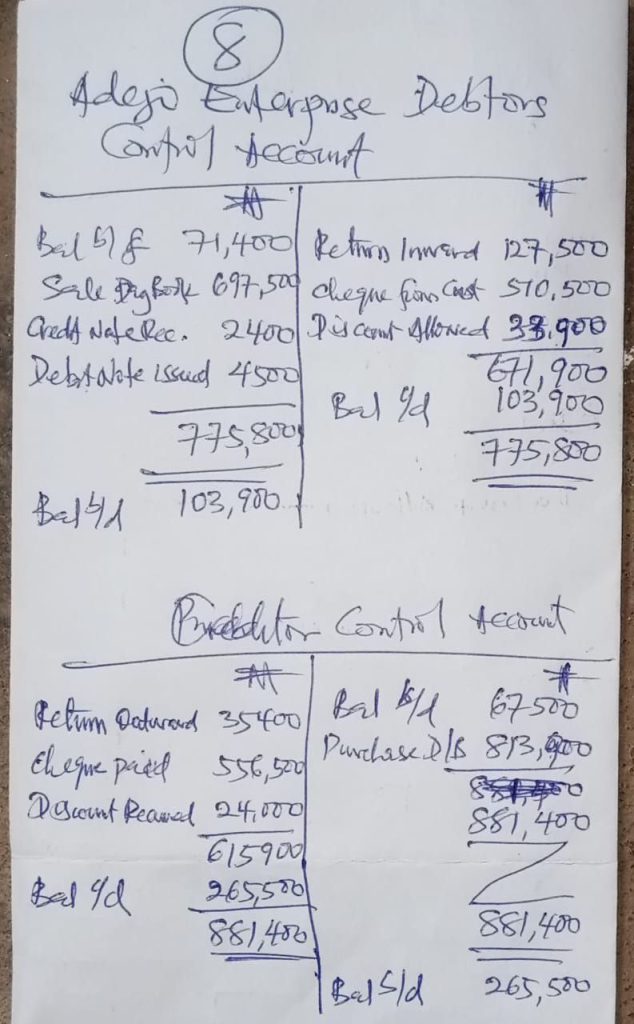NECO Bookkeeping OBJ 2025
01-10: CDADDCDEBC
11-20: CCECDCDBAC
21-30: ADDDAACEDD
31-40: BDECBACDBA
41-50: CBDCECBDBC
51-60: CDEBDBEEEA
COMPLETED!!!
NECO Bookkeeping Essay 2025
Number 1
Answers Loading…
==================
Number 2
(2a)
A trading account is prepared to determine the gross profit or gross loss of a business from buying and selling goods during an accounting period. It shows the difference between sales and cost of goods sold (COGS).
(2b)
(i) Fixed Capital: This is capital invested in long-term assets like buildings, machinery, and land. It is not intended for day-to-day operations.
(ii) Working Capital: This is the capital used for daily operations of the business. It is calculated as current assets minus current liabilities.
(iii) Loan Capital: This is money borrowed by the business from external sources such as banks, to be repaid with interest.
(iv) Equity Capital: This refers to the money invested in the business by its owners/shareholders in return for ownership.
(v) Venture Capital: This is funding provided by investors to startups or small businesses with growth potential, often in exchange for equity or partial ownership.
(2c)
(i) Business Entity Concept
(ii) Money Measurement Concept
(iii) Going Concern Concept
(iv) Accrual Concept
(v) Consistency Concept
(vi) Prudence Concept.
==================
Number 3
(3a)
(i) First In First Out (FIFO): This method assumes that the earliest (first) stock purchased is the first to be issued or sold. It values closing stock using the cost of the most recent purchases.
(ii) Last In First Out (LIFO): This method assumes that the most recent (last) stock purchased is the first to be issued or sold. It values closing stock using the cost of the earliest purchases.
(iii) Weighted Average Price (WAP): This method calculates the average cost of all available stock (total cost divided by total quantity). All stock issued or remaining is valued at this average cost
(3b)
(i) Salaries and wages
(ii) Rent and rates
(iii) Insurance expenses
(iv) Depreciation of assets
(v) Repairs and maintenance
(vi) Advertising expenses
(vii) Electricity and water bills
(3c)
(i) Invoice
(ii) Receipt
(iii) Credit note
(iv) Debit note
(v) Cheque counterfoil
(vi) Payment voucher
==================
Number 5

==================
Number 6
(6i)
Preparation of Financial Statements for B. Oko and Sons as at 31st July, 2015
(i)Trading Account
Opening Stock:
N100,000
Purchases:
N112,000
Carriage Inwards:
N8,000
Less: Returns Outward:
N4,000
Cost of Goods Available for Sale:
N100,000 + N112,000 + N8,000 – N4,000 = N216,000
Less: Closing Stock:
N21,000
Cost of Goods Sold:
N216,000 – N21,000 = N195,000
Sales:
N250,000
Less: Returns Inwards:
N8,000
Net Sales:
N250,000 – N8,000 = N242,000
Less: Goods drawn for domestic use:
N9,000
Net Sales for Trading Account:
N242,000 – N9,000 = N233,000
Gross Profit:
N233,000 – N195,000 = N38,000
(6ii)
Profit and Loss Account
Gross Profit:
N38,000
Add: Discount Received:
N2,000
Total Income:
N38,000 + N2,000 = N40,000
Less: Expenses:
Salaries and Wages:
N10,000
Electricity:
N3,200
Insurance:
N3,500
Discount Allowed:
N500
Carriage Outwards:
N2,800
Stationery and Printing:
N2,400
Rent and Rates (N6,000 – N8,000 prepaid):
N6,000 – N8,000 = (N2,000) (This indicates that Rent and Rates are overpaid and should be treated as an asset in the balance sheet, not an expense in the P&L for the current period)
Depreciation on Equipment (10% of N50,500):
N5,050
Depreciation on Furniture (5% of N12,000):
N600
Total Expenses:
N10,000 + N3,200 + N3,500 + N500 + N2,800 + N2,400 + N5,050 + N600 = N28,050
Net Profit:
N40,000 – N28,050 = N11,950
(6iii)
Balance Sheet as at 31st July, 2015
Assets
Current Assets:
Cash in Hand:
N5,000
Debtors:
N20,000
Closing Stock:
N21,000
Rent and Rates Prepaid:
N8,000
Fixed Assets:
Equipment at Cost:
N50,500
Less: Accumulated Depreciation (Equipment):
N5,050
Net Book Value (Equipment):
N45,450
Furniture at Cost:
N12,000
Less: Accumulated Depreciation (Furniture):
N600
Net Book Value (Furniture):
N11,400
Liabilities
Current Liabilities:
Creditors:
N6,000
Long-term Liabilities:
Loan:
N12,000
Equity
Capital (Opening):
N66,000
Add: Net Profit:
N11,950
Less: Drawings (Goods):
N9,000
Closing Capital:
N66,000 + N11,950 – N9,000 = N68,950
Total Assets should equal Total Liabilities + Equity
==================
Number 7

==================
Number 8

COMPLETED!!!
